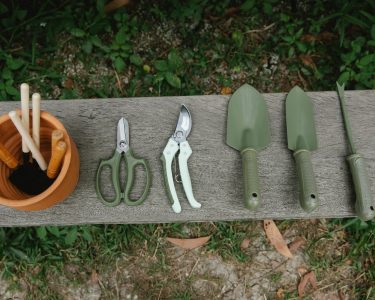Are you looking to add some color and life to your yard? Flower beds and borders are a great way to create a beautiful landscape that will leave all of your neighbors envious. Not only do they provide visual interest, but they also attract pollinators like bees and butterflies. In this blog post, we’ll cover everything from planting techniques to maintenance tips so you can create stunning flower beds and borders in no time! So grab your gardening gloves, it’s time to get started.
What is a Flower Bed?
A flower bed is a designated area of your lawn or garden where you plant and grow various types of flowers. It can be any shape or size, depending on the available space in your yard and personal preferences. Flower beds are usually designed to add color, texture, and interest to the landscape around them.
There are many different types of flower beds to choose from, including raised beds, container gardens, rock gardens, border gardens and more. Each type has its own unique benefits and challenges when it comes to planting and maintaining them.
Depending on the location of your flower bed within your yard, you might need to consider factors such as sun exposure or soil quality before deciding what plants will thrive there. Some popular choices include annuals like petunias or marigolds which bloom for one season only while others prefer perennials which regrow year after year like daisies or lilies.
No matter what type of flower bed you create in your yard it’s important that they fit cohesively with their surroundings while also providing a beautiful visual display for everyone who sees them!
What makes a good flower bed?
A good flower bed is essential in creating an attractive landscape. It’s not only about planting different types of flowers, but it also involves planning and designing to create a cohesive and aesthetically pleasing arrangement.
One key factor that makes a good flower bed is the selection of plants. You should choose flowers with varying heights, colors, textures, and blooming times to add depth and interest to your flower bed. Additionally, it’s important to consider the climate conditions in your area when choosing suitable plants for your garden.
Another aspect that can make or break a flower bed is its shape and size. The shape should complement the surrounding landscape while still being visually appealing on its own. Consider using curves or geometric shapes rather than traditional rectangular beds for added interest.
The placement of your flower bed is also crucial in determining its success. A well-placed flower bed can enhance other features of your yard such as walkways or patios while adding color and beauty at the same time.
Proper maintenance plays a significant role in keeping your flowerbed looking great throughout the year. This includes regular watering, fertilizing, pruning dead blooms, removing weeds regularly among others.
What makes a good Flower Bed is attention-to-detail when selecting plants based on their height/texture/blooming-times/climate-conditions; thoughtful consideration into shape/size/placement within one’s backyard; consistent upkeep through proper watering/fertilizing/pruning/weeding etcetera
How to Plant a Flower Bed
Creating a flower bed is not just about digging a hole, putting the plants in, and watering them. A beautiful flower bed requires proper planning, preparation, and execution to ensure that the plants thrive and bloom to their fullest potential.
Before planting your flowers, make sure you have selected the right location for your flower bed. Look for an area with good drainage, adequate sunlight exposure and where they won’t be overcrowded by other plants or trees.
Once you have found the perfect spot for your flower bed, it’s time to start preparing the soil. Clear any weeds or debris off of the ground and loosen up any compacted soil with a garden fork or tiller.
Next step is adding organic matter such as compost or manure into your soil mixture to add nutrients that will help your flowers grow healthy.
When choosing which type of flowers to plant consider factors like color scheme preference ,blooming seasonality & height variations so that there is always something beautiful blooming throughout year-round.
Always follow planting instructions on seed packets . Plant deeper rooted perennials first then topsoil should go over roots followed by annuals planted lastly at top layer of soil covering all visible areas until theres no empty spaces left.
Lastly water thoroughly but avoid flooding- too much water can damage new delicate roots!
Care and Maintenance of a Flower Bed
Once you have planted your flower bed, it’s important to take proper care of it to ensure that your plants thrive and look their best. One of the most important aspects of maintaining a healthy flower bed is watering. Watering frequency will depend on the specific needs of each plant, but generally speaking, aim for about an inch of water per week.
Another key factor in caring for a flower bed is soil health. Make sure that the soil is well-draining and nutrient-rich, as this will help your plants grow strong and vibrant. Fertilize periodically with balanced fertilizer according to package instructions.
Weeds can also be a problem in any garden or landscaping project, so make sure you pull them out regularly by hand or use organic weed control methods. Deadhead spent blooms regularly to promote new growth and prevent disease.
Pay attention to pests such as aphids or spider mites which can damage your flowers quickly if left unchecked. Consider using natural pest control methods like companion planting or insecticidal soap depending on the severity of infestation.
By following these tips for care and maintenance, you’ll keep your flower beds looking beautiful all season long!
How to Create Beautiful Borders with Flower Beds
Incorporating flower beds and borders into your landscape is an excellent way to add color, texture, and depth to your outdoor space. By following the steps outlined in this article, you’ll be well on your way to creating a beautiful and functional garden that will bring joy for years to come.
As you start planning out your flower beds and borders, remember that there’s no right or wrong way to do it. The most important thing is to choose plants that suit your style preferences and the environmental conditions of your yard.
So don’t be afraid to experiment with different layouts, colors, shapes, and textures until you find what works best for you. And above all else – have fun! Gardening is a great hobby that can provide both physical exercise and mental relaxation. Enjoy the process of creating something beautiful from scratch!



